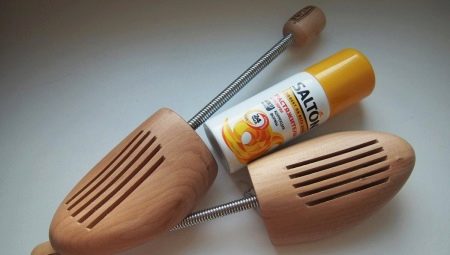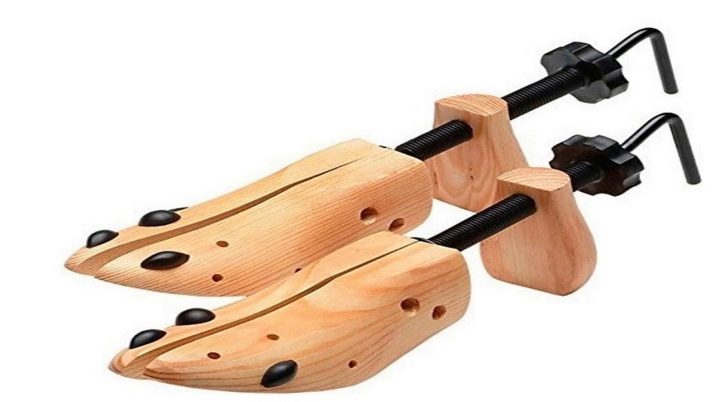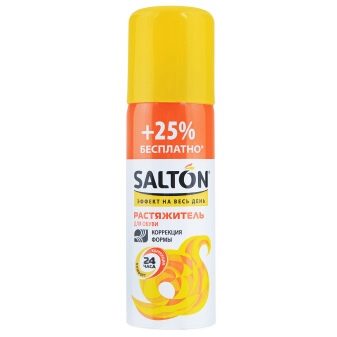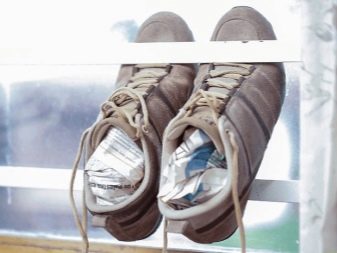Stretchers for shoes: features, types, recommendations for choosing

Many of us have encountered the problem of too tight shoes rubbing our feet. In previous years, the situation was corrected with the help of a variety of folk remedies, nowadays there are special devices - they allow you to stretch shoes by mechanical or chemical action. All of these methods are designed to adjust shoes from a wide variety of materials, each with its own characteristics of use, advantages and disadvantages.

Features and types
Quite often, men and women come across stylish shoes, boots or boots that suit them in all their characteristics, but at the same time they are a little tight. This is not a reason to refuse an interesting option. - there are special devices with which you can stretch shoes and boots in width.


Our mothers and grandmothers stretched shoes with improvised means or even folk methods, so they adjusted the shape or size of the pair. Some of them are still relevant today.
- Treatment of shoes with an alcohol-containing solution. In this case, the inner and outer surfaces of the vapor are abundantly lubricated with liquid, it is best to do this with a spray bottle. After processing, the shoes should be put on their feet and walked in them until they are completely dry.
- Castor oil. With this composition, you should thoroughly lubricate the products from the inside, as well as from the outside, then put your shoes on toes and do not take them off for several hours. The oil will not only correct pressure and tightness, but additionally remove the squeak in the sole. If you don't have castor oil, you can use petroleum jelly.
- Boiling water... If you have neither alcohol nor oil at your disposal, try simply treating your shoes with hot water. However, keep in mind that this method can be used for models made of genuine leather; it is unacceptable for leatherette and textiles. A pair of shoes should be treated with boiling water, cooled slightly and worn on a thin toe until dry.
- Vinegar. Only the inner surface is treated with this composition, as a result, excessive pressure on the legs is quickly and effectively removed.
- Wet paper. There is another interesting way to stretch the shoe, for this it is filled with damp paper from the inside and dried naturally.
- Ice. This method may sound strange, but it always gives good results. In order to expand the shoes, you need to put a plastic bag filled with water in them and put them in the freezer. The liquid freezes and turns into ice, in accordance with the laws of physics at this moment it begins to increase in volume and stretch the shoes. The most important thing here is to take a responsible approach to work, the bag must be without holes, it must be tied very well, and it is better to additionally put it in the second bag.
And, of course, we advise you to pre-wash your shoes - remember that they will lie next to food. Keep in mind that the ice does not need to be removed immediately, let it melt slightly.



Now folk remedies have given way to professional stretch marks, which can be conditionally divided into two types: chemical and mechanical. They can be used both in tandem and separately.
Chemical stretch marks are presented foams and aerosolsas a rule, they are produced by companies that produce comprehensive shoe care products. The main advantages of such stretch marks include the following points:
- on sale you can find options for shoes of different types (from natural and artificial leather, from suede and textiles);
- chemical compositions do not leave stains and untidy streaks, do not change the shade of the product;
- stretchers not only pull, but also soften the skin, thus protecting it from tearing.


Mechanical stretchers are usually sold in shoe stores, they are a screw spacer, which is inserted into the shoe, and then by turning the screw, the width of the shoe is adjusted. Usually, such stretch marks are made of wood, metal or dense plastic; holes are often formed on the surface in order to complement the spacer with convex pads. By inserting them into the holes, you can adjust the width of the product in accordance with the individual physiology of the foot.
Such shoe accessories are often used for seasonal storage. - for this they are simply inserted into shoes and removed for several months. This helps protect the shoe from kinks and deformations.

What materials is it suitable for?
There are peculiarities of stretching shoes made of various materials. So, to increase the size of the boots genuine leather must be treated very carefully. In particular, for patent leather it is advisable not to use a mechanical stretcher, since this material may not withstand intense stress and will be covered with cracks.
Velor and suede modelson the contrary, it is advisable to stretch mechanically or even to wear it out using folk methods, since any chemical composition, even very light and weak, leaves marks that will not be easy to get rid of later.

Products made of synthetic materials are difficult to adjust, and the result is often unpredictable., because it is never 100% known from which raw material a pair of shoes is sewn. The best option would be to purchase a chemical stretcher for leatherette shoes, mechanical stretchers can be used exclusively at your own peril and risk.


We pay special attention to the fact that for suede, as well as lacquered and fabric shoes, do not use the effects of heat and cold.
The same methods are suitable for stretching boots as for stretching shoes. However, if you are dealing with boots with fur, then for easy stretching it is best to take castor oil or boot cream, and you can only lubricate the product from the outside. A good result is given by such a method as wearing boots on several pairs of wet socks at once - for this, they take woolen knee-highs, moisten them with hot water, wring them out, and then put on their shoes and walk around the house for about half an hour.
Of course, it will not work to carry the shoes in one go, so all attempts should be repeated many times. After each manipulation, shoes are stuffed with dry paper and dried away from heating appliances.


It is impossible to stretch rubber boots, since this material cannot be increased., in any case, it will take its original shape or break. However, these days, very often footwear that is sold as rubber, in practice, is made of polyvinyl chloride, this material can be slightly stretched.
In order to check what exactly the boots are made of, you can use a needle, for this they heat it up and pierce the boot in an inconspicuous place: if it starts to melt, it is PVC.
Manufacturers
Today on the market you can find universal stretchers from a variety of manufacturers that can be used for all types of shoes, with the exception of fur boots. Among them are:
- Salamander;
- Damavik;
- Silver;
- Salton;
- Pregrada.




Some products are considered by consumers to be the most effective.
- Shoe Stretch. This spray is designed to stretch shoes. To process, sprinkle the inner surface of the pair with the composition and pull it over tight socks. Thus, you should walk for 35-40 minutes - you will notice the result immediately.

We draw special attention to the fact that when using the spray on shoes made of expensive materials, you need to be careful. Do not forget to protect your eyes from contact with the composition during processing.
- Salton. The spray is suitable for stretching the material and softening it. Ideal for shoes made of a wide variety of materials. To achieve the effect, a pair of shoes should be sprayed every time before putting on, as a rule, after 3-4 treatments, it takes a shape that is comfortable for the feet. Try to avoid inhaling aerosol particles.

- Kiwi. This composition is intended for stretching all types of shoes, the aerosol is sprayed only in the place where boots, shoes or boots crush. After that, you should wear shoes for 30-40 minutes, if necessary, repeat the treatment. The spray is caustic and smells rather unpleasant, so try to avoid inhaling its vapors.


How to use?
Each stretching method has its own characteristics. For example, a narrow toe is best extended by cold or smearing the toe with Vaseline, Vaseline oil or cream. The use of paper lumps shows a good result, but a narrow backdrop can be softened a little differently. - for this they knock on it with an ordinary hammer.
You can also stuff your sock tightly with newspapers, and put ice packs in your heel. You can smear the back of your shoes with petroleum jelly or castor oil and walk for 3-4 hours until the backs soften and increase in width. If the backs are too hard and narrow, the inside of the shoes is smeared with dry solid deodorant, then put on a toe-box and worn out until the shoes stop chafing.
The bootlegs can be slightly widened using special mechanical stretchers, and you can use a damp newspaper to increase the lift of the shoes. Alternatively, you can sprinkle cereal into the sock and add a little water to swell.


Chemical stretchers are quite easy to use, but some manipulations are required. and they should be performed in strict accordance with the attached instructions. So, before use, you need to shake the balloon, and then check the material from which the shoes are made for color sensitivity. This is important if you plan to apply the product not only inside, but also outside.
The processed shoes are generously filled with foam, and after that they wait a couple of minutes until it settles. Then the shoes are put on a wooden block and wait until they dry completely, as a rule, this takes about half an hour. If there is no block, then you can carry the shoes on the foot.
Experts recommend applying a protective coating to the outer side of the shoe after processing. If necessary, all manipulations must be repeated two or three times.

Security measures
Improper use of shoe stretchers often leads to the most unpleasant consequences for the life and health of the wearer. So, inhalation of spray vapors may cause swelling and irritation of the mucous membranes of the respiratory tract and eyes. You do not need to apply foam and cream with your bare hands, be sure to wear gloves. It is correct to carry out processing on the street or on the balcony.
If the rules for using the stretcher are not followed, you can not only fail to get the expected result, but also hopelessly ruin your shoes without any opportunity to restore them in the future. First of all, this concerns tapping with a hard object, for example, a hammer. Of course, if we process army ankle boots in this way, then perhaps only this method will be effective, but in the case of ordinary men's and women's boots and boots, most likely, the result of such stretching will be broken seams, dents on the surface and creases.

Prohibited methods also include stretching the shoe to tear; mechanical stretching does not need to be done by pushing hard objects into the shoes. - the result of such actions is often deformation of the glued parts.
Useful Tips
A stretcher should be in every home, since none of us is safe from acquiring a pair that will not sit perfectly. Which stretch to prefer - chemical or mechanical, choose yourself at your discretion.
The mechanical option is preferable for those people who by nature have a rather wide leg or have bumps. Chemical compositions are optimal when the pressure of the shoe is negligible.


In any case, when choosing a stretcher, you should adhere to certain recommendations.
- Keep in mind that the shoe can only be stretched to the width. In length, shoes and boots practically do not stretch, no matter what processing method you use. If your toes rest on the front of the shoe or the heel chases a lot, just swap out a pair for a different size.
- Expensive natural leather products should not be pulled mechanically, this can cause significant damage. It is advisable to give such boots to a professional shoemaker for stretching.
- First, test any compound used to stretch the shoe on an inconspicuous area, say, on the inside. A high-quality composition should not change the shade of the product and its texture, leave traces.
- Keep in mind that after any chemical stretch marks, natural skin loses its natural fats and becomes fragile, therefore, after each procedure, rub your shoes with conditioner or cream.


Review overview
Reviews of boot and shoe stretchers left by users on a variety of thematic sites in most cases indicate that this method of adjusting the width of the shoe at home really helps. Among the best means are the products of brands. Salton, Silver and Dividik. The rating of the most demanded stretchers also includes sprays of the company Girba.



At the same time, users point out that The formulations work best with leather shoes, but they practically do not work on sneakers and fabric products. Many owners of uncomfortable couples believe that one treatment of the inner surface will be enough to obtain the desired effect. This opinion is wrong. To change the size of shoes, boots and boots, you need to repeat the stretch marks at least three times.
See below for how to stretch your shoes.








